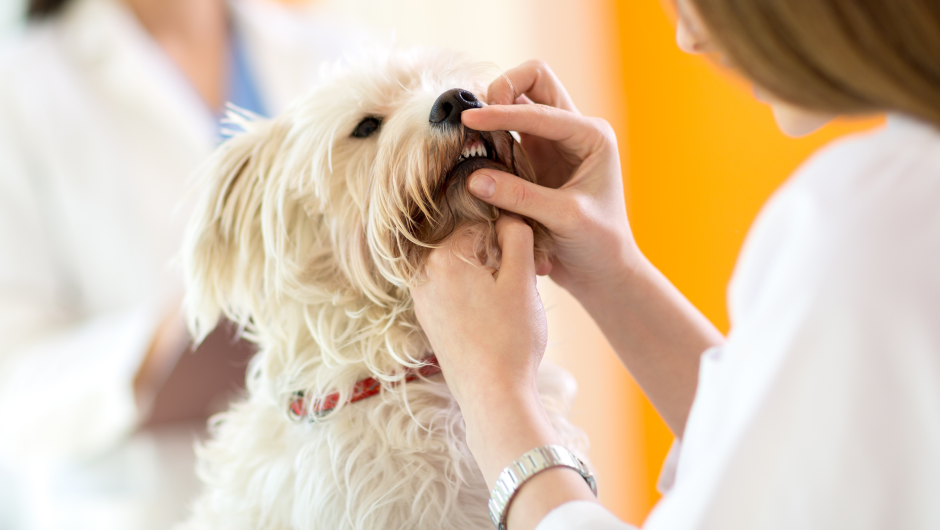Proper pet dental cleanings are exactly the same as they are for humans.
People, however, understand what is happening during the procedure and hold still, even though they don’t like the way it feels. Our pets, however, do not understand and typically will not hold still. They have to be forcibly restrained, which not only is traumatic and stressful, but also may lead to injury of the pet or the person who is attempting to restrain the pet.
The truth is that non-anesthetic pet dental cleanings are not the same as traditional pet dental cleanings; in fact, they do not even come close to a true dental cleaning. Instead, they are more cosmetic in nature and simply remove as much of the visible tartar and plaque build-up that is possible with this type of procedure. In recent years, a cottage industry has evolved that takes advantage of pet owners’ fear of having their pets placed under anesthesia. Sometimes it is groomers offering to brush a pet’s teeth, which, realistically, doesn’t accomplish anything useful (Imagine if you only brushed your teeth every four to eight weeks!). There are individuals-occasionally veterinary technicians or dental hygienists -that travel from town to town, offering non-professional dental scaling’s on animals that have not been sedated.
I cannot emphasize enough how stressful and painful it is for your pet, but also how it does not offer any long-term or even short-term health benefits.
The cause of bad breath and kidney problems is the bacteria in the plaque that is under the gumline. Periodontal disease originates in these deep, odor-producing pockets that require probing and scaling with sharp instruments. There is a reason why our dentists sometimes use nitrous oxide (laughing gas) and novocaine shots while they are working under our gumlines; this degree of probing and scaling, which is necessary to complete a thorough cleaning, can be quite painful.
The danger is that a pet owner may falsely believe that his pet is now safe from periodontal disease when nothing can be farther from the truth. In fact, the risk of developing this disease could be made worse by the scratches left on the teeth by the instruments used. Bacteria and plaque will find their way more quickly into those tiny scratches. That is why our dentist always finishes a cleaning by using a high-speed polisher on your teeth.
The Misunderstood Truth about Anesthesia
What most pet owners don’t understand is that anesthesia actually is considered very safe. A recent study conducted nationally revealed that only one in 10,000 veterinary patients had an adverse experience when placed under anesthesia. The American Animal Hospital Association will not certify any veterinary hospital that does not perform dental procedures under general anesthesia with intubation. Intubation refers to the breathing tube used in anesthesia. Use of this tube is critical in keeping the bacteria scraped off the teeth from getting into your pet’s lungs where it potentially can cause a number of problems. People can close their throat and swallow, but an anesthetized animal cannot. A restrained animal which is fighting and breathing rapidly is equally at risk of breathing in bacteria.
Regular Pet Dental Cleanings Should Be Part of Your Pet’s Health Care
Veterinarians have done a great job of educating pet owners about the imperative need for preventative dental care for their four-legged family members. And here’s why it is so important- by three years of age, approximately 85 percent of dogs already have periodontal disease that needs medical attention. In fact, many popular toy breeds lose permanent teeth as early as five years of age if preventative dental care is not performed. The new challenge for veterinarians is to prevent pet owners from being lulled into a false sense of security by these non-professionals who are offering an ill-advised procedure. In a recent article, Dr. Jan Bellows, a Diplomate of the American Veterinary Dental College, stressed the following key points about veterinary dentistry:
- Because pets age rapidly, veterinarians should examine the teeth of their patients twice a year.
- Proper teeth cleaning requires anesthesia.
- Non-professional teeth cleanings are primarily cosmetic and do not address moderate-to-advanced periodontal disease and other health issues.
- Pet dental cleanings without anesthesia can be stressful and painful for pets

